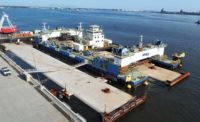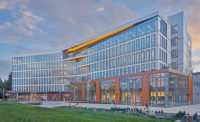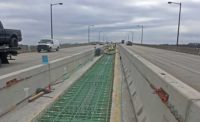Elizabeth River Tunnels Project
Portsmouth and Norfolk, Va.
Region ENR MidAtlantic
Highway/Bridge
Project Team
Owner Virginia Dept. of Transportation
Lead Design Firm/Civil Engineer WSP USA Inc.
General Contractor SKW Constructors (a Skanska USA, Kiewit Construction, Weeks Marine Inc. JV)
Developer/Concessionaire Elizabeth River Crossings OpCo LLC
Construction Quality Control Lead Consultant HNTB Corp.
Subcontractors Conley Environmental Corp.; Waterfront Marine Construction Inc.; Norfolk Dredging Co.; Seaward Marine Corp.
Fabricated at a former dry dock for World War II ships located near Baltimore, 11 concrete tubes—each 10 times larger than a subway car—were towed 220 miles down the Chesapeake Bay by tugboats to Portsmouth, Va., without incident. But when crews plunged the first 16,000-ton tube 95 ft beneath the Elizabeth River’s surface in July 2015, they were concerned about load readings on lowering cables. “We noticed immediately a little bit of rocking motion in that tube,” says Wade Watson, project director for design-build joint venture SKW Constructors, which built the $2.1-billion Elizabeth River Tunnels project. “We had to completely reverse the operation.”
 After lifting the element from the bottom of the river and immediately notifying the Virginia Dept. of Transportation (VDOT), the team ultimately determined that gravel bedding in the riverbed, despite being screeded within spec, was slightly thicker in the middle than it was on the ends.
After lifting the element from the bottom of the river and immediately notifying the Virginia Dept. of Transportation (VDOT), the team ultimately determined that gravel bedding in the riverbed, despite being screeded within spec, was slightly thicker in the middle than it was on the ends.
The tube couldn’t be immersed again until the bed was leveled to a new half-inch tolerance a few days later, Watson says. The new spec was used for the remaining 10 concrete elements. Crews immersed them one at a time and linked them underwater with a series of locking mechanisms and seals to complete the nearly 3,800-ft-long tunnel. “If we weren’t on our toes, it could’ve been set that way,” Watson says of the first tunnel element, “but we noticed it and wanted to do the right thing.”
Watson says such close communication and transparency with VDOT was critical to successfully delivering the project under a public-private partnership (P3) that involved one of the first all-concrete, immersed-tube tunnels designed for deep water in the U.S. The tunnel’s concrete mix satisfies durability mandates for a 120-year design life and had a high resistance to cracking, Watson says.
The project team constructed multiple, simultaneous project components, including a 1.1-mile elevated extension of the Martin Luther King Expressway, two buildings, five pump stations and 10 bridges. The team also performed flood-control and rehabilitation work to three existing tunnels, including the Midtown Tunnel that was considered the most congested two-lane road east of the Mississippi prior to the project.
Since finishing one year early last year, the tunnels have saved the average commuter up to 60 minutes per daily round trip. They also have helped decrease emissions, increased roadway safety and improved the local economy by making it easier to move goods and services, says Watson, who won a 2016 ENR Top 25 Newsmaker award for leading the work. The project also improved the river’s ecosystem. The team removed thousands of tons of contaminated soil during the dredging process as well as chemically treated piles. They also used waste concrete to make oyster boxes to foster oyster spats in the river. One tunnel portal was fitted with a movable 20-in.-thick, 40,000-lb steel flood-gate system to protect the interior from a 500-year event with a 2-ft sea-level rise.
The project’s OSHA recordable incident rate was less than two during 5 million worker-hours. One Best of the Best judge called the project “fascinating,” praising the team’s ability to overcome the difficulties and challenges in the very congested area, allowing it to come in ahead of schedule.
Putting the P in P3
The team spent the first six months of the project’s design period building rapport with all the owner stakeholders. Watson says the joint venture took the atypical step of sharing early design calculations with VDOT and their consultants before construction began. “Most people don’t want to be too open with those items,” says Watson, noting that the JV also revealed certain proprietary means and methods to help put the calculations in context.
The owner’s group worked near the JV’s co-location trailer, which also housed lead design firm WSP USA Inc. “It was certainly the most communicative project I’ve ever worked on in 35 years. Everyone was right there during construction,” says the project’s design manager, Fred Parkinson.
Parkinson, a WSP vice president who worked on South Carolina’s highly collaborative Cooper River Bridge replacement project in the early 2000s, was nevertheless unnerved by sharing the calculations. Ultimately, he says, it helped build trust in the design-build and P3 process, during which, he says, owners have less control than they do in bid-build projects. Parkinson says the transparency worked so well that WSP and Skanska plan to be just as open if they win future tunnel projects together in the region.
Taking a Toll
The JV’s design-build contract covered the new and rehabilitated tunnels as well as site and bridge work and the expressway extension. The Macquarie-Skanska consortium known as Elizabeth River Crossing (ERC) financed the project and is operating and maintaining the tunnels and other facilities for a 58-year concession period.
Although VDOT is overseeing the developer’s activities and operation, the public roundly criticized the deal with ERC because the concessionaire was given the right to escalate toll prices during the concession period. Former Secretary of Transportation Aubrey Layne said in media reports: “It was a great project and a terrible deal.”
Opponents have decried tolls on the rehabilitated Midtown Tunnel, too. ERC wanted to reinstate tolls on the tunnel, which were removed in the 1980s, when it took over tunnel maintenance in 2012. Former Virginia Gov. Bob McDonnell’s administration negotiated a delayed toll implementation until 2014. Meanwhile, the Virginia Supreme Court in 2013 rejected Portsmouth Circuit Court Judge James A. Cales Jr.’s ruling that the tolls were unconstitutional, amounting to taxation without representation.
Watson notes that during public hearings prior to construction, many residents understood the need for tolls and just wanted them to be “reasonable.” Watson now says, “I think that’s what the project did.”
Saying the project “wouldn’t be built” without tolls, Parkinson points to the fact that tolls were permanently removed from the Martin Luther King Freeway Extension, which he called one of the “most popular” parts of the project. “It allows a much more free-flowing connection between the tunnels,” he says. “It’s a much more pleasant area and reliable area to get around.”
Parkinson adds that the project was a partial “impetus” for creating the Hampton Roads Transportation Accountability Commission in 2014 to help procure, finance, build and operate the region’s highway, bridge and tunnel projects.
Early Bird
Watson acknowledged that the sole-proposal project was “politically challenged” in that it was originally negotiated by the McDonnell administration but completed on former Gov. Terry McAuliffe’s watch. “That just goes to show you that you need to be even more open,” Watson says. “You have to be transparent with the department even from the cost standpoint and schedule standpoint.”
Initially scheduled to be completed in May 2018, the project’s original six-year contract had no margin for error. After the project started, however, the team was able to add resources and perform some activities simultaneously to open the new tunnel six months early in June 2016.
After the new tunnel was completed, the team shaved another six months off the original 18-month tunnel rehabilitation schedule by performing much work underneath the travel lanes without closing them and keeping single-lane closures to non-peak hours. The final tunnel rehab opened a year early in May 2017.
Watson says finishing the project early had the added bonus of helping avoid even more bad press. “There was a lot of good news out of the construction side,” he says. “Maybe less on the tolling side.”
Immersion Blender
During the bidding process, the team considered other options for building the tunnel elements, such as using steel hybrid sections. Watson says the all-concrete tubes, among other things, were easier to float through the deep waters from the casting yard to the project site. Careful calculations were used to cast the approximately 350-ft-long, 55-ft-wide and 28.5-ft-high concrete elements so they floated high enough during the journey. The team also achieved design-weight tolerances by meticulously tracking the weight of the materials.
Watson worried the tunnel bulkheads would dislodge during immersion, as they have in other immersed-tunnel projects. To avoid that difficulty, Watson explains that they cast a notch into the end of the tubes where the water pressure forced the bulkhead into the notch, “even though it was probably overkill a bit.” The team also says using concrete bulkheads is a first for deepwater tunnel elements.
The team traveled to several all-concrete immersed-tunnel project sites around the world, including Skanska’s Bjørvika project in Oslo, Norway. Watson says the trips taught them how to design the joints between the tunnel sections and gave them insight into survey-control work as well as how to cast “relatively crack-free” concrete. Parkinson says the trips helped them better reinforce the concrete and make it watertight.
Given the fact that only one member of the design team had direct experience with the specific immersion technique being used, the team conducted extensive training sessions. The immersion process required ample ballast to submerge the elements. Two to three ft of concrete was pumped into the bottom of the tunnel elements, creating the curvature for the tunnel’s road. Water tanks inside the tunnel were filled with 4 million gallons of river water to help immerse the elements.
Using a special barge, the 12-hour immersion process involved sophisticated GPS, underwater radar and sonar technologies to help position the concrete tubes. A hydraulic arm was used to pull the tubes together to form a watertight seal between the sections. The entire process unfolded on screens in the control room like a video game. “Somebody asked me where we found the operator. I told him we went down to the beachfront and got the highest scoring kid from the arcade,” Watson quips.
















Post a comment to this article
Report Abusive Comment